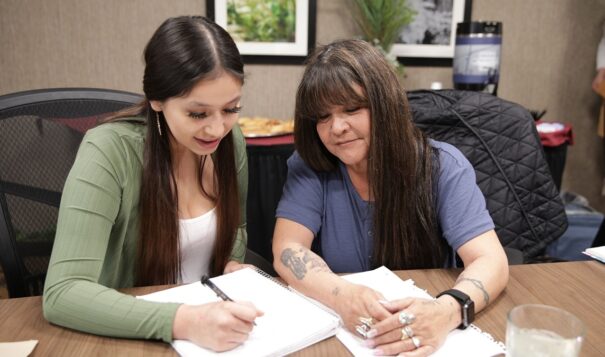News Based on facts, either observed and verified directly by the reporter, or reported and verified from knowledgeable sources.
Good news for Indian Country: Business lenders find Native borrowers safe bet
 Up to half of loan applicants in the program are Native women. Courtesy Federal Reserve Bank of Minneapolis
Up to half of loan applicants in the program are Native women. Courtesy Federal Reserve Bank of Minneapolis
Native American borrowers tend to pay back loans on time, making them likely candidates for assistance from Community Development Finance Institutions, a new report reveals. Yet, pairing Indian Country entrepreneurs and the CDFIs remains a challenge, experts explain.
The institutions’ role is to channel funds to stimulate low-income neighborhood housing, health, and other projects. Native CDFIs’ mission is to build economic prosperity through accessible business loans in underserved Indigenous areas. The U.S. Department of the Treasury backs the institutions it has certified for this purpose, such as banks, credit unions, and local loan funds.
“Native CDFIs, in general, have very low delinquency rates, so what we’re studying is delinquency within an industry where it’s quite rare,” says Laurel Wheeler, an economist and research fellow at the Center for Indian Country Development, part of the Federal Reserve Bank of Minneapolis. The center presented its report on Native lending practices on July 11 at the bank’s second event of the webinar series Cultivating Native Economies in the 21st Century.
Wheeler said Native CDFI borrowers in a sampling of 484 business loans showed a 3.9% delinquency rate over a 90+ day period, which is thought to be lower than business borrowers from other demographics. However, the files don’t reveal any data compared to other borrowers.
With data compiling comes responsibility and restraint, says Lakota Vogel, a member of the Cheyenne River Sioux Tribe and executive director of the Four Bands Community Fund. She discussed how the study unpacked relevant questions that Native CDFIs had without unnecessary probing.
“I really strongly believe in the importance of data sovereignty for Indigenous communities,” said Vogel. “Data does not make itself. Data is created and shaped by the perceptions of the makers. How you perceive is how you proceed.”
Based on the data collected by Oweesta and Sweetgrass Consulting, Native CDFI borrowers range from 18-96 years old, are 50% female, and 83% AIANNH. The Center for Indian Country Development found that the CDFI median loan amount is around $5,500.
“Native CDFI borrowers in a sampling of 484 business loans showed a 3.9% delinquency rate over a 90+ day period, which is thought to be lower than business borrowers from other demographics. However, the files don’t reveal any data compared to other borrowers.”
Laurel Wheeler, economist and research fellow at the Center for Indian Country Development
According to Pete Upton, the CEO and Chairman of the Native CDFI Network, most Native CDFIs experience success on loans over $5,000, while $50,000 to $150,000 have the best results. When instances of delinquency and late payment crop up, financial literacy is the biggest obstacle within Indigenous communities.
Around 16% of AIAN households have no account with a bank/credit union, according to a 2019 survey the FDIC published in 2020. Instances of financial illiteracy may result from that inexperience, not talking about money due to trauma, a cultural difference on viewing money, as well as a lack of investing and being invested in.
Other determinants for loan delinquency include credit score, household income, character score, commitment to business, and client engagement. Based on the study, the CICD found that character-based and relationship-based lending might improve loan outcomes.
For Upton, a member of the Ponca Tribe of Nebraska, understanding where his clients are coming from is essential for his work.
When he finds instances of delinquency, he reaches out to the client to figure out why. Most of the time, by checking in and arranging meetings a few times a year, he begins to get an understanding of outside factors that may prevent loans from being paid back. Certain circumstances such as medical bills, illness, death, and alcoholism tend to be some of the factors that stall loan payments to CDFIs.
“Sometimes we’re the last resort for an individual coming in to get a loan from us,” said Upton. “That’s one of the first things that we will get. You know, we always look at character because I think character is the number one aspect of lending, especially in the markets that we lend to.”
Character-based considerations include assessment of client engagement in the borrowing process, client characteristics such as support networks and reputation in the community, and measures of the client’s commitment to business.
With a character credit score, “the lender incorporates subjective information about potential borrowers’ character to provide credit to clients that would otherwise be labeled as “high risk,” according to the CICD study.
With the addition of the recent research and data conducted by the CICD, lenders have a better idea of how to assist the underserved market.
Vogel emphasized that Native CDFIs have an open-door policy backed by extensive online resources supporting regions.
Depending on manpower and financial capacity, Upton said, out-of-state financial institutions may be able to aid tribal members in Northern Great Plains states such as North Dakota, which currently has four Native CDFIs.
“As the Native CDFI Network, what we need to do is be accessible and offer any support that we can to the North Dakota groups and find out what resources they have in place and what resources we can bring to them,” Upton said.
